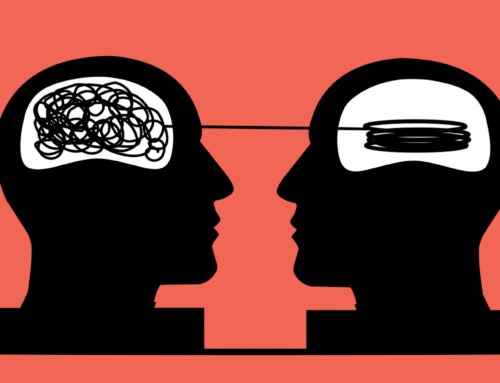We know events like childhood trauma cause physiological changes in one’s body. These changes in turn correlate with behavioral changes that manifest themselves as symptoms, and what psychiatry and its DSM-5 do is assign labels to certain clusters and combinations of these symptomatic manifestations, with each label representing and naming an individual and distinct mental illness.
The problem with the Psychiatric research paradigm (otherwise known as the biomedical model) is that it focuses on these physiological changes of the brain as the ultimate causes of these mental illnesses, while relegating trauma, abuse, poverty and environmental factors that contribute to these brain changes as irrelevant, secondary, or unaddressable in the study of the etiology of the disease. This worry has been expressed by the British Psychological Society in their 2011 Response to the American Psychiatric Association:
“The Society is concerned that clients and the general public are negatively affected by the continued and continuous medicalisation of their natural and normal responses to their experiences; responses which undoubtedly have distressing consequences which demand helping responses, but which do not reflect illnesses so much as normal individual variation. (p.1)”
“We believe that classifying these problems as ‘illnesses’ misses the relational context of problems and the undeniable social causation of many such problems. For psychologists, our well-being and mental health stem from our frameworks of understanding of the world, frameworks which are themselves the product of the experiences and learning through our lives. (p.4)”
This response is one that echoes critiques of psychiatric diagnosis and practice coming from within the field itself by some of its biggest names. My target in this piece is the continued overemphasis on locating biomarkers and neural correlates for mental illness to the exclusion or diminution of the social forces at play that are themselves equally important links in the causal chain that create the conditions for mental illness to manifest. The reasoning goes like this:
Environmental factor → Brain changes → Behavioral changes.
The subtle move is to focus on those physiological changes as the sole relevant causes for the behavioral symptoms, and pharmacology then takes over to “fix” or counteract these changes in the brain. Note:
Leading the charge is the National Institute of Mental Health, whose Strategic Plan for Research states that “Fundamental to our mission is the proposition that mental illnesses are brain disorders expressed as complex cognitive, emotional,and social behavioral syndromes”. This statement goes well beyond the available scientific data (Satel & Lilienfeld, 2013). It assumes what remains to be proven. Yet this type of rhetoric is rampant in our field. Researchers refer to the “fundamental biological substrates of behavior” when they speak and write. Clinicians explain to patients how psychological disorders are caused by “underlying brain or neurotransmitter abnormalities.” Advertisements for psychotropic medications strongly reinforce this sentiment.
But by continuing to insist that brain changes are the ultimate causes of these symptoms, it gives us a reductionist account of mental illness that will lead to dead ends in research. Note for instance the effects that the childhood trauma of incest can have on our well-being:
After making sure that Marilyn was getting the proper medical care, I consulted with two of my colleagues at Massachusetts General, psychiatrist Scott Wilson and Richard Kradin, who ran the immunology laboratory there. I told them Marilyn’s story, showed them the picture she’d drawn, and asked them to collaborate on a study. They generously volunteered their time and the considerable expense of a full immunology workup. We recruited twelve women with incest histories who were not taking any medications, plus twelve women who had never been traumatized and who also did not take meds — a surprisingly difficult control group to find. (Marilyn was not in the study; we generally do not ask our clinical patients to be part of our research efforts.)
When the study was completed and the data analyzed, Rich reported that the group of incest survivors had abnormalities in their CD45 RA‑to‑RO ratio, compared with their nontraumatized peers. CD45 cells are the “memory cells” of the immune system. Some of them, called RA cells, have been activated by past exposure to toxins; they quickly respond to environmental threats they have encountered before. The RO cells, in contrast, are kept in reserve for new challenges; they are turned on to deal with threats the body has not met previously. The RA‑to‑RO ratio is the balance between cells that recognize known toxins and cells that wait for new information to activate. In patients with histories of incest, the proportion of RA cells that are ready to pounce is larger than normal. This makes the immune system oversensitive to threat, so that it is prone to mount a defense when none is needed, even when this means attacking the body’s own cells.
Our study showed that, on a deep level, the bodies of incest victims have trouble distinguishing between danger and safety. This means that the imprint of past trauma does not consist only of distorted perceptions of information coming from the outside; the organism itself also has a problem knowing how to feel safe. The past is impressed not only on their minds, and in misinterpretations of innocuous events (as when Marilyn attacked Michael because he accidentally touched her in her sleep), but also on the very core of their beings: in the safety of their bodies.
Research on childhood trauma provides a treasure trove of examples of the ways that social acts or events (war, incest, abuse) affect our biology, which in turn can lead to mental health illnesses such as borderline personality disorder, the etiology of which can be best described as both biological and environmental:
- One study found a link between the number and type of childhood traumas and the development of personality disorders. People with borderline personality disorder, for example, had especially high rates of childhood sexual trauma.
- Verbal abuse. Even verbal abuse can have an impact. In a study of 793 mothers and children, researchers asked mothers if they had screamed at their children, told them they didn’t love them or threatened to send them away. Children who had experienced such verbal abuse were three times as likely as other children to have borderline, narcissistic, obsessive-compulsive or paranoid personality disorders in adulthood.
– Andrés Ruiz








Leave A Comment